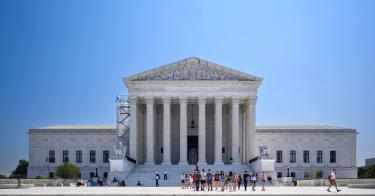In a landmark, unanimous decision last week, the Supreme Court pushed back against the Biden administration’s regulatory overreach by returning the Clean Water Act to its original purpose and restoring federalism.
In 2004, Chantell and Mike Sackett had just begun backfilling on their land in Priest Lake, Idaho, when the Environmental Protection Agency ordered the family to restore the site to its original state or pay fines upward of $40,000 per day.
Why exactly?
The EPA claimed that the Sacketts were in violation of the Clean Water Act, asserting that their construction activity was discharging pollutants into surrounding wetlands that the agency deemed to be “waters of the United States” and therefore subject to federal regulation.
The Clean Water Act is a federal statute that allows the EPA and the Army Corps of Engineers to regulate “navigable waters.” In the past, both the EPA and Corps have attempted to introduce vague interpretations of these waters, which delivered the Washington bureaucracy a perfect opportunity to expand its power.
Luckily for all Americans, the Supreme Court ruled May 25 in favor of the Sacketts. The high court issued a judgment in Sackett v. EPA in line with the late Justice Antonin Scalia’s plurality opinion in a separate major Clean Water Act case, Rapanos v. United States.
Scalia’s opinion in that 2006 case held that the term “waters of the United States” can refer only to “relatively permanent, standing, or flowing bodies of water,” and “does not include channels through which water flows intermittently or ephemerally or channels that periodically provide drainage for rainfall.”
At the time, Scalia’s opinion didn’t have the necessary five votes to achieve a majority of the nine justices.
Until last week, that is, when the Supreme Court honored the plurality by determining in Sackett v. EPA that the use of “waters” in the Clean Waters Act “refers only to ‘geographic[al] features that are described in ordinary parlance as “streams, oceans, rivers, and lakes”’ and to adjacent wetlands that are ‘indistinguishable’ from those bodies of water due to a continuous surface connection.”
In other words, the Supreme Court provided a succinct definition of “waters” under the Clean Water Act, providing a legal defense for rolling back federal overreach.
For years, The Heritage Foundation has fought for these exact reforms, urging the Supreme Court to adopt Scalia’s opinion and offer much-needed clarity on how to define waters of the United States. In doing so last week, the court has provided agencies with the necessary tools to develop a regulatory framework for waters of the United States that properly reflects Supreme Court decisions, the Clean Water Act, and the Constitution.
The court’s decision presents a major challenge for the Biden administration, which earlier this year issued a final rule that revised the definition of waters of the United States and wrongfully expanded the regulatory authority of the EPA and Army Corps of Engineers over U.S. waters.
Past administrations have made similar attempts to place control over nearly every body of water imaginable in the hands of the federal government. Now, the Biden administration’s interpretation of waters of the United States may be entirely thrown out by the courts.
The new Supreme Court ruling also carries weight for many Americans, since it returns regulatory, decision-making power over wetlands and waterways back to the states and private property owners, just as the Clean Water Act originally intended.
Because states and localities are closest to issues such as water pollution, they should be the ones determining the process and tailoring policies to address those problems—not federal bureaucrats in Washington.
In addition, historical interpretations of the Clean Water Act and its associated harsh civil and criminal penalties have left property owners virtually paralyzed from conducting normal activities, such as homebuilding and farming, on their own private land. Now, families can expect much greater regulatory clarity.
Until now, pushing back against the Biden administration’s draconian interpretations of the Clean Water Act, as well as those of previous administrations, has been an upstream battle.
The Supreme Court’s decision in Sackett v. EPA is a major step in the right direction for common sense, states’ rights, and private property rights. It could provide a legal precedent for fighting other instances of the EPA’s overreach.
This piece originally appeared in The Daily Signal



